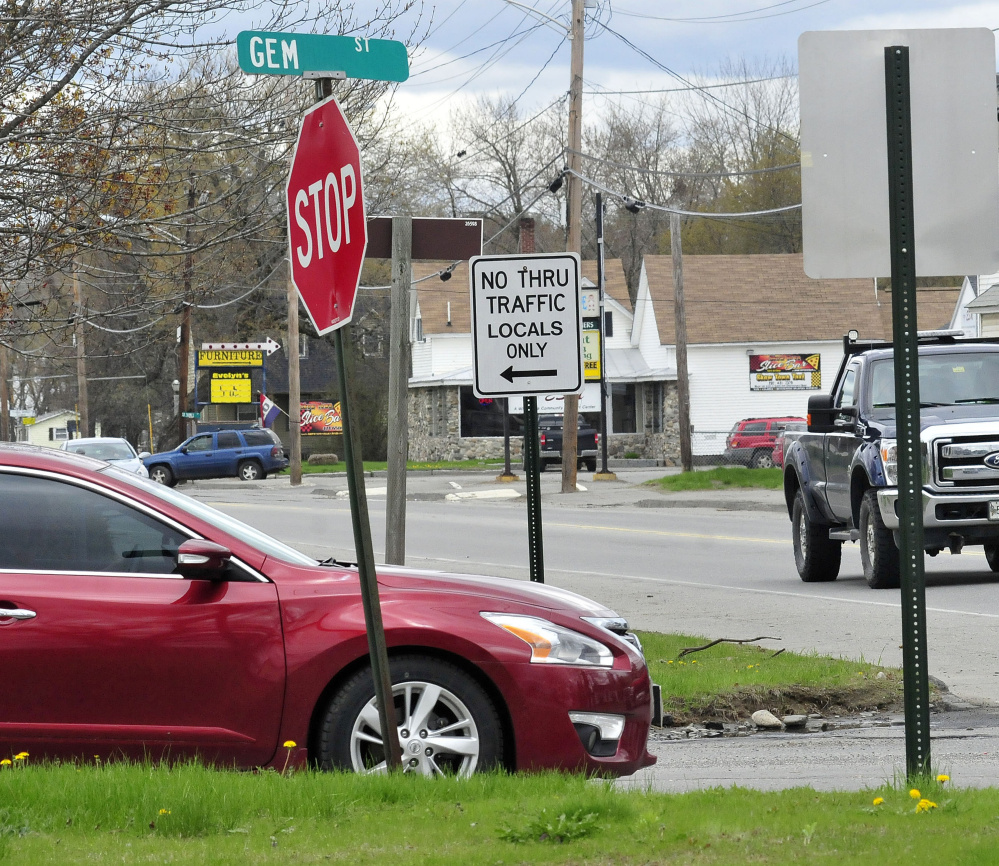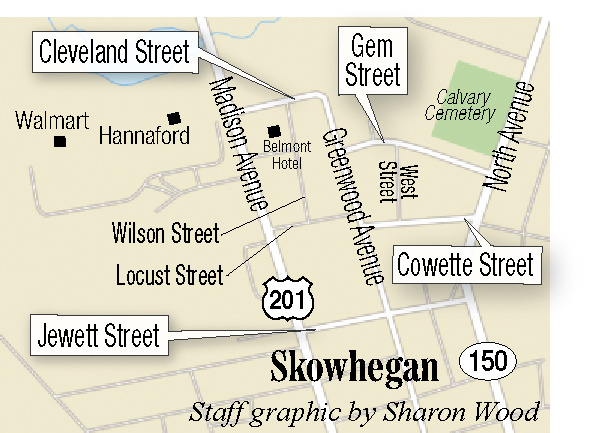Traffic problems in Skowhegan, which are to be the topic of a public hearing Tuesday night, may have been hatched decades ago when the original layout for streets between Madison Avenue, North Avenue and Jewett Street was altered.
Skowhegan Road Commissioner Greg Dore said Monday that one of the streets — Gem Street — didn’t even exist on an old map that hangs in the Selectmen’s Room at the Town Office. Cemetery Street, as it was known then, didn’t go all the way through to Greenwood Avenue as Gem Street does now — it turned at West Street, finally leading to Jewett Street.
Gem Street ultimately was extended to Greenwood Avenue, making a quick and easy shortcut from one side of town to the other. Then came all the big box stores and shopping plazas along Madison Avenue and with them heavy traffic.
Gem Street has been one of the streets studied by Dore since complaints about traffic and speeding cars were raised by business owners and residents.
The public hearing is set for 5:30 p.m. in the Municipal Building on Water Street.
Dore said his department did a traffic count and found that 11,449 cars and light trucks used Gem Street in both directions over the course of one week to get to one side of town to the other. He said 34 percent of those motorists were exceeding the speed limit. About 5,500 cars were counted on Cowette Street that week.
Changes were made. Streets were made one-way, stop signs were installed, as were “Do not enter” signs. Then changes were made to the changes. Gone were the one-way street signs on Gem, Cowette and West streets in Skowhegan, installed to eliminate shortcuts through the residential neighborhood between North Avenue and Madison Avenue. Motorists were allowed to use the two streets for two-way traffic — but they are not allowed to enter either street from North Avenue.
Two weeks ago signs saying “No thru traffic; locals only” went up, but the speeding continued and the traffic volume is still a problem.
The whole problem started April 17 when Gem Street and Cowette Street were made one-way from Madison Avenue — where they meet Greenwood Avenue and Cleveland Street next to the Belmont Motel and across from the Hannaford supermarket — to North Avenue. Speeding and traffic congestion prompted complaints from residents in the neighborhood, so Skowhegan selectmen took action. The area that includes West Street, Locust Street and Wilson Street is a residential subdivision, not meant to be a shortcut across town, they said.
So far, nothing seems to have worked in most areas, except Cowette Street, where “Do not enter” signs remain and traffic has diminished, Dore said. In other areas of the residential neighborhood, fewer cars were going through, but they were going faster, Dore said.
At Tuesday’s public hearing during the regular meeting of the Board of Selectmen, Dore said town officials want to hear from residents and business owners on Gem Street. The problem is motorists “cutting through” from Madison Avenue and North Avenue.
Solutions could include speed tables, like speed bumps, and more stop signs.
“We really need to find out if people who live in that neighborhood think this is a problem,” Dore said Monday. “The complaints I got from Gem Street was that they weren’t told anything about it when we started the changes. The one-way was a real problem for a few of them.”
Since making the area local traffic only, the complaints have stopped, he said.
The Skowhegan Planning Board also is looking into the problems, Town Manager Christine Almand said.
Dore also has drafted a “traffic calming” policy, based on regulations in the city of Portland.
Under the proposed policy, 10 or more residents from any given area of town could file a petition with the town clerk for review of their traffic complaints. The petition then would be sent to the road commissioner and each selectman. Any member of the Board of Selectmen also could initiate the process. The road commissioner would analyze the complaint and report back to the selectmen with his findings for final action by them.
Almand said part of the solution to street woes is to have the public aware that there is a problem and slow down or take another route to places such as Wal-Mart.
“Awareness — any time you make changes it brings awareness to an issue,” she said. “And whether folks agree to the changes or not, it does bring awareness.”
Doug Harlow — 612-2367
Twitter:@Doug_Harlow
Send questions/comments to the editors.





Comments are no longer available on this story